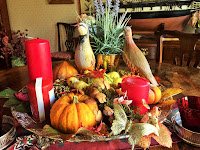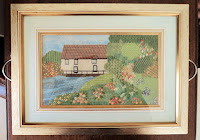Making my first YouTube
YouTube tutorials are wonderful, featuring a mass of things
you had thought of and even lots one didn’t even think existed. The beauty of being actually able to see the
process rather than trying to work out with diagrams from a printed source is
particularly good with a craft such as Needlepoint/Tapestry.
My daughter in fact learnt to knit from watching a number of
tutorials, they encouraged her to try something for the first time and
something, and I confess, her Mother had not taught her!
Having enjoyed my needlepoint for almost 50 years, first as
a relaxation from full time interior decorator, then as a designer, author and
in particular a teacher, I realised that showing students exactly how to stitch
something was of considerable help. So
much so that more than 30 years ago I started ‘Needlepoint Network’ a group of
trained people who taught my designs on class in their own area.
 |
| Imogen and Anna |
Recently needing more help in the studio, particularly with
communications with existing students I met up with Imogen. It turns out that besides being far better
able to keep students and additional interested people in touch she had
recently done a film editing course and had already been involved with making
one for a group of musicians.
My next decision was what particular aspect of needlepoint I
should feature; needlepoint/canvas work has been popular with stitchers and
highly prized by collectors for centuries. There are marvellous examples
stitched by Mary Queen of Scots in the sixteen hundreds, there are amazing
examples of Opus Anglicanum (church embroidery) from the 15 century and while
considerable later the early American settlers worked beautiful pieces.
My final decision to feature Florentine as the first subject,
was arrived at for many reasons;
firstly it has been enjoyed by needle persons (I don’t on
purpose use the term needlewomen as there were many professional men who were
excellent) over the generations; it was
around 1660/70 that the fashion for furnishings (bed hangings table covers, and
cushions in Florentine or Flame point designs) supplanted pictures, stump work
and samplers;
In reasonably simple forms it is a perfect first project; it
is an excellent choice for cushions, upholstery, garments such as waistcoats, purses;
rugs and wall hangings as well as small items for gifts.
 It has a number of
very descriptive names, Bargello, Flame Point and in some Victorian books Rail
Road (due to the comparative speed of execution, however do remember that the
trains mid 19C did have a man walking in front to control the speed)
It has a number of
very descriptive names, Bargello, Flame Point and in some Victorian books Rail
Road (due to the comparative speed of execution, however do remember that the
trains mid 19C did have a man walking in front to control the speed)
I also love doing Florentine work and have many examples
which over the series I shall enjoy sharing with the viewers.
So, to the first Florentine Tutorial which is in 5 parts, we
decided that a pattern with five shades of crewel wool would be an excellent
introduction; in addition to finishing up with an attractive piece many tips
and suggestions for all one’s future work was explained and demonstrated. These sessions cover the selection of
materials and colour, the canvas and the advantages of working on a frame,
setting up the pattern to obtain an attractive balance and good wear, in the
last session how making up, surround with fabric and trimmed with a hand-made
cord does the stitching justice.
 |
| Different Colour Schemes |
We were able to demonstrate just how versatile even just
five shades of wool cold be; for the
main core piece a traditional scheme of Flames and Soft Greens was chosen but
also shown were samples of different placements of these shades, different
lengths of stitch, creating both gentle and bolder schemes.
Also illustrated are two completely different colour schemes
to give a contemporary look to their
piece. |
| Buy Now |
I do hope you enjoy watching the series, please let us have
your thoughts and any ideas of what you would like to see in future YouTube
tutorials as our thoughts are turning to
future programmes continuing the Florentine theme.
There are literally
hundreds of ideas I should like to share, designing one’s very own pattern;
using different threads such as overdyed floss, silks and even metallic; mixing
more than one pattern on a piece – possibly a bold border around a central
repeat pattern or columns of co-ordinated patterns for a long stool or rug or,
as I am planning at the moment, a pair of wedding kneelers for my granddaughter
inspired by a Victorian runner, I shall hope to share the progress with you.
 |
| Buy Now |
Florentine has always featured prominently in my books,
particularly ‘The Complete Needlepoint Course’ and ‘Needlepoint Stitch by
Stitch’ have whole chapters on this subject.
I have a few pre loved copies to sell, link are under there images.
Finally there will be a Gallery which will feature your
pieces to share and inspire others; we should love to have photos and short
details, canvas mesh, threads used and final destination – cushion, box top,
rug etc and the permission to use your given name.
I hope you enjoy watching the series on YouTube and I’d love
to know in the comments how your own projects turned out. I’d also be very
interested to know what needlepoint projects you’d like to see in future
tutorials.
Click here--> for "Introduction to Florentine" Episodes.




Comments
Post a Comment